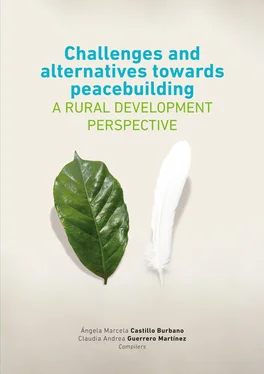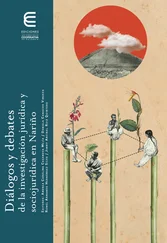The items of fundamental importance, which simply reiterate current policies, are: the commitment to treat drug consumption as a health issue, which in general terms is already accepted in the country; and the voluntarily eradication of illicit crops, although if this is not achieved or communities oppose, manual eradication may be used. Campesino farmers will not be punished criminally, a policy which is already in place and is part of any sensible drug policy (which should focus on the repression of traffic and prosecution).
Now, after the signing of the aforementioned Peace Agreement, with the post-agreement period reached, the outlook was encouraging, both for Colombians and for the rest of the world. The people of Nariño believed that the war would finally be over, however, we are still very far from that wish becoming a reality. In the territory, the conflict for power, the struggle for the territories, drug trafficking, the illegal economy, all remain the same or stronger than before the Peace Agreement. The FARC did at first leave their weapons, however, non-demobilized ex-combatants formed new groups, which then imposed themselves upon the territory. Social leaders are now being killed for promoting the practice of peaceful coexistence; leaders who fight for the eradication of illicit crops and now give more value to peace and subjective factors that money cannot buy.
An unfiltered look shows there are no significant changes; there is even more violence Children and young people remain without opportunities, levels of education are low, informal employment is commonplace with the illegal economy paying more than the legal one, the culture of ‘conflict resolution being won by the strongest’ continues to generate displacements and the cultivation of illicit crops continues without check.
So, the questions would be: “What failed in the agreement? Where is the effective and lasting peace spoken of by Santos’ government?” One of the underlying problems is drug trafficking. The Government committed itself to “implementing policies and programs” to deal with drug-produced corruption, however, the programs are inefficient. In Nariño, farmers subscribed to the program of substitution, which offered economic benefits for voluntary substitution; the Government guaranteed a period of time with decent wages, as well as capital for new ventures. Unfortunately, the advice and support, as well as the delivery of resources, has not been provided in a timely manner, leading to farmers to wait for the end of the subsidy to re-cultivate. Another factor that has made it impossible to eradicate illegal crops has been due to the advantages they hold over legal crops, for example: the purchase of illegal crops is guaranteed, illegal groups search for the product and reach the farms, no matter how distant they may be; Prices are high and do not fluctuate drastically, therefore, the farmer perceives profits. Additionally, legal crops have a weakness with regards to their commercialization. In Nariño, the campesinos are excellent producers, but they lack processes for the transformation of their produce into value added products. They suffer from price fluctuations, a lack of access routes and the absence of associativity that would facilitate the combining of capacities, thereby strengthening their competitiveness within the sector. It is evident that illicit crops and therefore drug trafficking, are managed by illegal groups that move invisible threads and bring rupture to the social fabric, violence and desolation. On the other hand, in territories where illicit crops are not present, there is evidence of greater social cohesion, security and peace. Even though the rural sector has its share of problems, they are still territories of peace.
Conclusions
The post-agreement in Colombia has not generated the expected impact on the Nariño territory. The presence of illegal groups, the dissent of the FARC and the ELN have truncated the long-awaited peace in this territory.
Policies that favor the rural sector exist, however, the Government has not been able to give dynamism to the policies and this, together with the high corruption rates within the country, are a strong limitation. Regulations are lax and a culture that leads Colombia to believe that ‘rules are there to be broken’ has led to a number of social problems that impede peacebuilding.
Conflict is inherent in the human condition, therefore there is no “post-conflict”. Conflicts are present in every aspect of life; the problem is that there is no culture to resolve them. There is a lack of peaceful negotiation strategies; the belief is that if one party wins, the other loses. This, adds to the distrust and individualism that characterizes the Nariñense, leading to each one entrenching their position.
Peace in Colombia has become a utopia, the cost of war in the country has reached alarming figures that exceed investment in education and health. Nariño requires energizing agreements and the implemention of existing policies that really transform the culture of the territories with opportunities, education and social inclusion.
References
Melo, J. O. (2016).Resumen del acuerdo de paz. Revista de Economía Institucional, 18(35), pp. 319-337. DOI: http://dx.doi.org/10.18601/01245996.v18n35.19
Ogliastri, E. (2001). ¿Cómo negocian los colombianos? Bogotá: Alfaomega. Recuperado de https://www.researchgate.net/publication/228387677_Como_negocian_los_Colombianos
Programa de las Naciones Unidas para el Desarrollo -PNUD. (2016). Paz desde los territorios, una mirada subregional - Agenda de Paz Nariño 2013-2015. Pasto: Autor. Recuperado de: http://www.co.undp.org/content/dam/colombia/docs/Paz/undp-co-MiradaSubregional4-2016.pdf
Tejada Zabaleta, A. (2008). Análise de um modelo integral baseado no paradigma da complexidade para a compreensão, definição, avaliação e aplicação das competências (tesis de doctorado). Instituto de Psicologia, Universidade de são Paulo, São Paulo.
Zuleta, Estanislao. (2015). Sobre la guerra. Revista Universidad de Antioquia, 334. http://aprendeenlinea.udea.edu.co/revistas/index.php/revistaudea/article/view/22402/18546
| how to cite this chapterSalas, L.A, Montenegro, F.A. & Benavides, J.A (2020). A sociodemographic view and a look at health conditions prior to the implementation of peace agreements in the municipalities of Leiva, Policarpa. In Á. M. Castillo Burbano & C. A. Guerrero Martínez (comps.), Challenges and alternatives towards peacebuilding: a rural development perspective (Philippe White, Transl.) (pp. 67-118). Bogota: Ediciones UCC & Centro Editorial Uniminuto. (Original title published in 2019). https://dx.doi.org/10.16925/9789587602388 |
Chapter III
A sociodemographic view and a look at health conditions prior to the implementation of peace agreements in the municipalities of Leiva, Policarpa and Los Andes in Nariño
Luis Andrés Salas Zambrano, Franco Andrés Montenegro Coral y Julie Andrea Benavides-Melo
Abstract
Knowledge of the factors that influence the health status of a population and their casuistry is important when directing prevention strategies at the local level, as well as when guiding the actions of the provision of health services by the corresponding entities. In this chapter, the epidemiological profiles of three municipalities in the department of Nariño (Leiva, Policarpa and Los Andes), beneficiaries of the “Alternativas de desarrollo rural para la construcción de paz” or “Rural development alternatives for peacebuilding” program, will be addressed. The profile of each municipality was constructed by reviewing key documents such as: the analysis of the health situation of the department of Nariño with the model of social determinants, ASIS, epidemiological bulletins with the basic health indicators of the department of Nariño, municipal development plans, territorial planning schemes, population projections of the “Departamento Administrativo Nacional de Estadísticas” (DANE) or “National Administrative Department of Statistics”, and administrative management reports for the aforementioned municipalities for 2017 and 2018. A sociodemographic analysis is presented for each location, emphasizing the morbidity and mortality indicators in the population. According to the analysis of health indicators, problems are being evidenced that affect the physical, mental and social wellbeing of the inhabitants of the three municipalities at different life stages such as early childhood, childhood, adolescence, adulthood and the elderly. They are problems that intervene in a significant and unfavorable way in the development and progress of a municipality and its inhabitants, since health is vital and fundamental for work and school performance, in both the family and social environment. It was possible to identify health problems that require greater attention when planning intersectoral, cross-sectoral, community and individual actions of promotion and prevention, since these are the instances directly involved in the development of a new perspective of health; as it is the promotion of integral self-care that improves the quality of life of the affected communities.
Читать дальше












